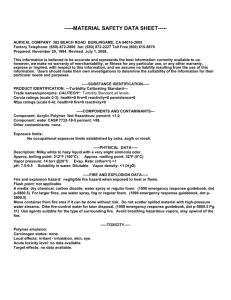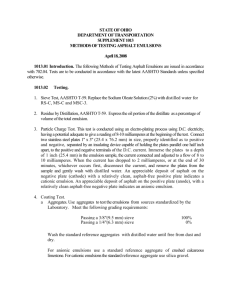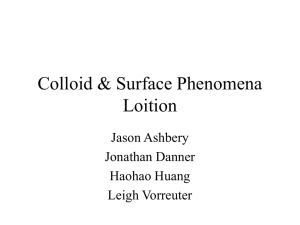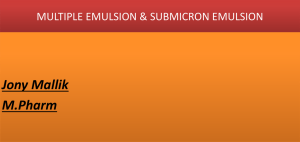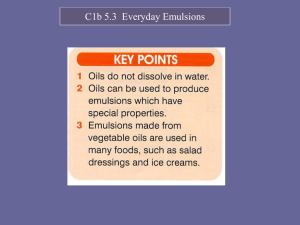20150430 Molecular interactions at the
advertisement
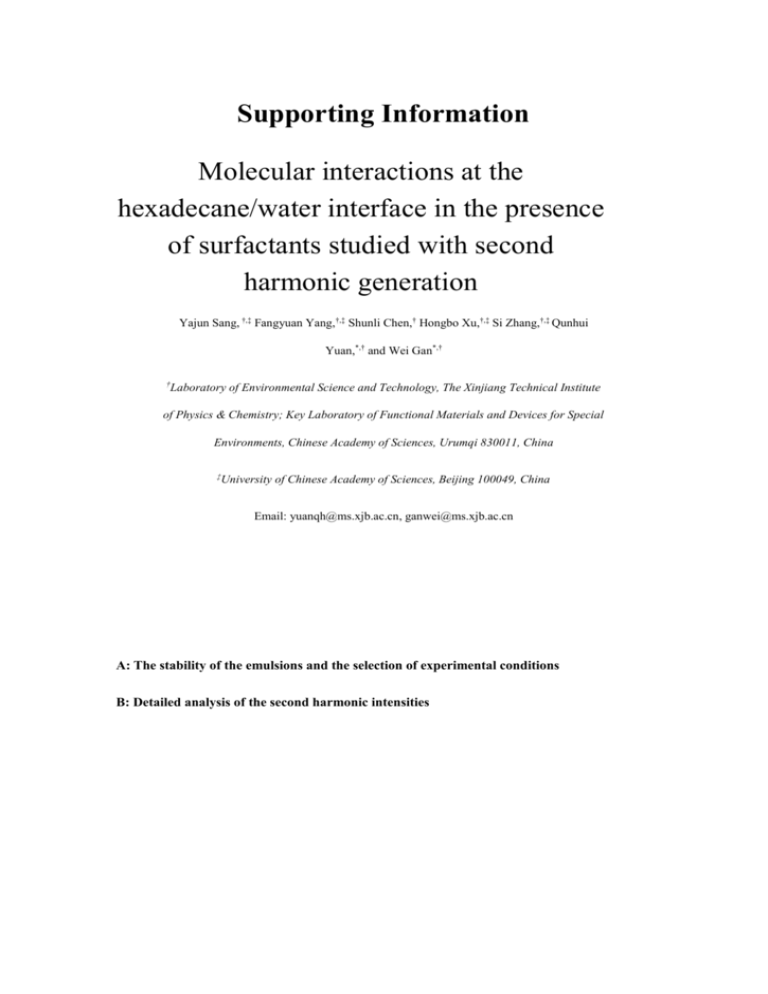
Supporting Information Molecular interactions at the hexadecane/water interface in the presence of surfactants studied with second harmonic generation Yajun Sang, †,‡ Fangyuan Yang,†,‡ Shunli Chen,† Hongbo Xu,†,‡ Si Zhang,†,‡ Qunhui Yuan,*,† and Wei Gan*,† † Laboratory of Environmental Science and Technology, The Xinjiang Technical Institute of Physics & Chemistry; Key Laboratory of Functional Materials and Devices for Special Environments, Chinese Academy of Sciences, Urumqi 830011, China ‡ University of Chinese Academy of Sciences, Beijing 100049, China Email: yuanqh@ms.xjb.ac.cn, ganwei@ms.xjb.ac.cn A: The stability of the emulsions and the selection of experimental conditions B: Detailed analysis of the second harmonic intensities A: The stability of the emulsions and the selection of experimental conditions The as-prepared emulsion was with droplet diameter ranging from 200 to 300 nm. With the hexadecane purified by alumina columns, the prepared emulsion was with a relatively wide size distribution as shown in Figure S1 and with a polydispersity index as approximately 0.4. The stability of the emulsion during the SHG experiments was monitored by measuring the diameter of the oil drops. The addition of MG and the surfactants were controlled in a range within which the emulsion tends to holds its stability and only measurements from emulsion monitored to be stable during the experiments (with less than 15% change in droplet diameter, which was comparable to the fluctuation of the DLS measurement) was used to analyze the adsorption process. The adsorption free energy and saturated MG density values presented were averaged values based on at least 3 repetitions. (a) Stability of the emulsion Figure S1 shows the time dependent size distribution of the oil droplets in a freshly prepared emulsion. It could be noticed that the size of the oil droplets kept almost unchanged within 18 hours. In the SHG experiments, the emulsion was used within 5 hours after the preparation to ensure the stability of the sample. Figure S1: The time dependent size distribution of the oil droplets in a freshly prepared hexadecane/water emulsion. (b) Stability of the emulsion after the addition of MG Because the adsorption of the positively charged MG ions neutralized the negative charges at hexadecane/water interface,1-4 the addition of MG was kept below 2 micromolar to ensure the stability of the emulsion during the SHG measurement. Figure S2 shows the diameter change of the oil droplet in the emulsion with the addition of MG at various concentrations. Figure S2: The measured diameter of the oil droplet in hexadecane/water emulsion after the addition of MG at various concentrations. (c) Stability of the emulsion after the addition of SDS and MG The addition of SDS stabilized the hexadecane/water emulsion. In the presence of SDS at concentration beyond 5 μM, the emulsion after the addition of MG with concentration up to 33 μM was found to be stable. In the presence of SDS with concentration at 0.1 μM, 0.5 μM, and 1 μM, the emulsion kept stable after the addition of MG with concentration of 2 μM, 2 μM, and 17 μM, respectively. Above concentration range was selected for the titration experiments. Typical data from the DLS measurements are shown in Figure S3. Figure S3: The left panel is the measured average diameter of the oil droplets in the hexadecane/water emulsions after the addition of SDS at various concentrations. The red and blue curves in the right panel are the DLS measurements of the oil droplets in the presence of 1 M SDS, before and after the addition of 33 M MG, respectively. (d) Stability of the emulsion after the addition of Tween80 and MG The addition of Tween80 also stabilized the oil/water emulsion. In the presence of Tween80 at concentration beyond 2 μM, the emulsion kept stable after the addition of MG with concentration up to 17 μM. This concentration range was selected for the titration experiments. In the presence of Tween80 at lower concentration, the addition of MG was still kept below 2 μM. Typical data from the DLS measurements are shown in Figure S4. Figure S4: The left panel is the measured average diameter of the oil droplets in the hexadecane/water emulsions after the addition of Tween80 at various concentrations. The red and blue curves in the right panel are the DLS measurements of the oil droplets in the presence of 2 M Tween80, before and after the addition of 17 M MG, respectively. (e) Stability of the emulsion after the addition of CTAB and MG The emulsion was found to be stable in the presence of CTAB at concentration beyond 0.5 μM. Once the emulsion was stabilized with CTAB, it kept stable with the addition of MG with concentration up to 33 μM. This concentration range was selected for the titration experiments. Typical data from the DLS measurements are shown in Figure S5. Figure S5: The left panel is the measured average diameter of the oil droplets in the hexadecane/water emulsions after the addition of CTAB at various concentrations. The red and blue curves in the right panel are the DLS measurements of the oil droplets in the presence of 1 M CTAB, before and after the addition of 33 M MG, respectively. B: Detailed analysis of the second harmonic intensities The obtained signal at 405 nm wavelength in the titration experiment was subjected to attenuation because of the absorption caused by the emulsion and the MG molecules in the solution at 405 nm wavelength. So it was corrected with the measured absorbance of the emulsion and the MG solution with concentration used in the experiments. At 405 nm wavelength, the emulsions absorb ~44% of the signal, while the MG molecules in the solution absorb 0-29% of the signal, depending on the concentration (The values presented here is calculated based on the UV-vis measurements as shown in Figure S6, considering a 0.65 cm pass length for the signal in the cuvett). After the correction with these two factors considered, the actual value of the signal at 405 nm wavelength generated from the focus point of the laser was obtained. Also, the emulsions absorb ~14% of the fundamental laser at 810 nm wavelength, thus cause a decrease of ~26% for the obtained signal. This factor was also corrected in the treatment. The obtained value was further corrected by subtracting the Hyper-Rayleigh scattering and the relatively weak tail contribution from the two photon fluorescence of the MG molecules in the emulsions, which was measured with the same experimental setup as used in the SHG experiment and also corrected considering its self-absorption. Then the Hyper-Rayleigh scattering of water and the SH radiation from surfaces of oil droplets, that were significantly smaller than the real signal (after correction considering the absorption of the emulsion, the sum of the two was less than 10% of the real signal) was also subtracted. The obtained value was then plot with the concentration of MG added in the solution for further analysis. Figure S6: The black curve is the UV-vis spectra of the emulsion used in the experiments. The red curve is the spectra after adding 33 μM MG in the emulsion. The corrected SH intensity is in proportional to the square of MG coverage at surfaces of oil droplets in the emulsion.5 The surface coverage (𝛳) of MG molecules could be related with MG concentration in the emulsion with the modified Langmuir model described by Wang et al. 6 𝛳=𝑁 𝑁 𝑚𝑎𝑥 = 𝐶+𝑁𝑚𝑎𝑥 +55.5⁄𝐾−√(𝐶+𝑁𝑚𝑎𝑥 +55.5⁄𝐾)2 −4𝐶𝑁𝑚𝑎𝑥 2𝑁𝑚𝑎𝑥 (S1) with N as the number of MG adsorbed at the surface of oil droplet, Nmax as the saturated number of MG adsorbed at the surface of oil droplet, C as the total concentration of MG in the emulsion, K as the adsorption equilibrium constant, which could be used to calculate the adsorption free energy by ∆𝐺 = −𝑅𝑇𝑙𝑛𝐾. Figures S7, S8 and S9 show the SH intensities in the titration experiments after the addition of MG in the presence of SDS, Tween80 and CTAB at various concentrations. The fitting with Equation S1 was also plotted as the solid lines. Please be noted that the fitting to data in Figure S8-d and Figure S9 always resulted in negative Nmax values, which are with no physical meaning. At the same time, acceptable fitting to the SHG data could be consistently achieved with relatively small positive Nmax values. This implies small saturated MG densities at the oil/water interface in these emulsions. Also, the adsorption free energy values obtained from all acceptable fittings with physically allowed Nmax values only slightly changed within the uncertainty presented in the main manuscript. In these cases, since the exact Nmax values were not able to be determined with the fitting, we estimated them based on comparison of the SH intensities, with the SH intensities from emulsions that are with similar chemical environment and with Nmax values accurately determined by the model fittings. It is known that the concentration of MG+ changed with the acidity of the solution because of MGOH+H + with a pKa value of 6.9.7-10 The concentration of the equilibrium MG + + H 2O k k1 -1 the MG+ in the solution at pH 6 was estimated to be 89% of the total MG molecules used to prepare the solution. This factor was considered in the calculation of the MG density at the interfaces. (a) Titration curves with the emulsion containing SDS of various concentrations Figure S7: The SH intensity curves in the titration from the emulsion containing SDS with concentration of 0.1 μM (a), 0.5 μM (b), 1.0 μM (c), 5.0 μM (d), 10 μM (e), 50 μM (f), 100 μM (g), 250 μM (h), 500 μM (i), 750 μM (j), 1 mM (k), 2 mM (l), and 4 mM (m), respectively. (b) Titration curves with the emulsion containing Tween80 of various concentrations Figure S8: The SH intensity curves in the titration from the emulsion containing Tween80 with concentration of 0.5 μM (I), 1.0 μM (II), 2.0 μM (III), 3.0 μM (IV), 4.0 μM (V), and 5.0 μM (VI), respectively. (c) Titration curves with the emulsion containing CTAB of various concentrations Figure S9: The SH intensity curves in the titration from the emulsion containing CTAB with concentration of 0.5 μM (I), 1.0 μM (II), and 2.5 μM (III), respectively. References: 1. K. G. Marinova, R. G. Alargova, N. D. Denkov, O. D. Velev, D. N. Petsev, I. B. Ivanov and R. P. Borwankar, Langmuir 12 (8), 2045-2051 (1996). 2. J. K. Beattie and A. M. Djerdjev, Angew Chem Int Edit 43 (27), 3568-3571 (2004). 3. P. Creux, J. Lachaise, A. Graciaa, J. K. Beattie and A. M. Djerdjev, J Phys Chem B 113 (43), 14146-14150 (2009). 4. A. J. Ma, J. Xu and H. L. Xu, J Phys Chem C 118 (40), 23175-23180 (2014). 5. H. F. Wang, T. Troxler, A. G. Yeh and H. L. Dai, J Phys Chem C 111 (25), 8708-8715 (2007). 6. H. F. Wang, E. C. Y. Yan, Y. Liu and K. B. Eisenthal, J Phys Chem B 102 (23), 4446-4450 (1998). 7. R. J. Goldacre and J. N. Phillips, J Chem Soc (Jul), 1724-1732 (1949). 8. D. J. Alderman, J Fish Dis 8 (3), 289-298 (1985). 9. S. J. Culp and F. A. Beland, J Am Coll Toxicol 15 (3), 219-238 (1996). 10. J. Zeng, H. M. Eckenrode, S. M. Dounce and H. L. Dai, Biophys J 104 (1), 139-145 (2013).
